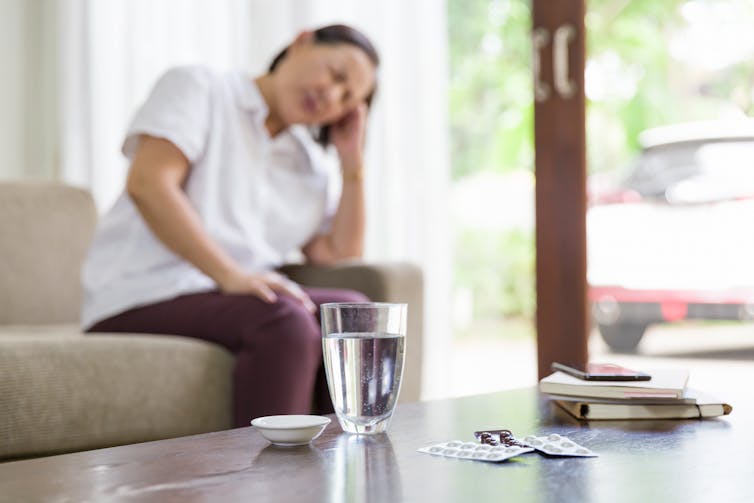Why do some people who take Paxlovid for COVID get 'rebound' symptoms? Or test positive again, like President Biden?
- Written by Lara Herrero, Research Leader in Virology and Infectious Disease, Griffith University

For many people with COVID, their recovery isn’t linear. United States President Joe Biden is one such person – he continues to test positive for SARS-CoV-2, the virus that causes COVID, and has experienced the return of a “loose cough”.
He returned a positive “rebound” test on Saturday, only days after testing negative for COVID.
President Biden was treated with the antiviral Paxlovid, in the hope this would allow him to recover faster and reduce his risk of severe disease.
What is Paxlovid and how does it work?
Paxlovid is a combination treatment that uses two different antivirals: nirmatrelvir and ritonavir.
Nirmatrelvir works to prevent the virus replicating. It does this by stopping a viral enzyme called a protease.
SARS-CoV-2, like many viruses, rely on proteases to “activate” them. Without the protease, the virus replication cycle cannot be completed and the virus can not become active.
So rather than “killing” the virus, it stops new “active” virus particles from being made.
Ritonavir is a “boosting agent” which prevents the metabolism of nirmatrelvir, meaning it stays in your system for longer.
Ritonavir has been used in low doses to boost the effectiveness of other protease antivirals in infections such as HIV.
Paxlovid treatment involves taking two nirmatrelvir 150mg tablets and one ritonavir 100mg tablet, together, every 12 hours for five days.
Like all antivirals, it’s important to start the course of Paxlovid as soon as possible after a diagnosis of COVID. This needs to be within five days of the onset of symptoms, so it can reduce virus replication and therefore reduce the spread of the virus in the body.
How effective is it?
In a clinical trial, Paxlovid showed an 89% reduction in the risk of hospitalisation and death. There were no recorded deaths among those who received treatment.
Compared to people in the study who didn’t receive the drug, Paxlovid treatment also reduced the viral load when measured on day five of the study.
Read more: I have mild COVID – should I take the antiviral Paxlovid?
So what is rebound?
Rebound is when a person appears to have recovered and “cleared” the virus, meaning they test negative on the very sensitive PCR test and have no symptoms. Then a few days later, they test positive again or symptoms return.
Rebound is not specific to people who have taken Paxlovid – it can also happen to others with COVID who didn’t receive any drug treatments.
A study that is yet to be peer reviewed (independently verified) has also found that patients’ symptoms and viral load can worsen after an initial period of improvement in some cases. While this is not true “rebound” it does suggest the course of infection may not be linear.
There have now been increasing reports of rebound effects in people who were treated with Paxlovid, including President Biden. Biden finished his five-day course of Paxlovid and tested negative to the virus. Three days later, he tested positive.
Why and how rebound happens is still not exactly known. What we do know is Paxlovid stops the virus in a person’s body from replicating. It doesn’t kill the virus already there. For that, we need the body’s immune system.
One theory is that a five-day course is not long enough to suppress the virus replication to allow the immune system to kick in and kill the virus.
Or perhaps the timing of when treatment starts affects how the immune system kicks in.
Another theory is the drug is not being taken as prescribed. Research into the cause of Paxlovid rebound is ongoing.
Read more: COVID drugs in Australia: what's available and how to get them
A recent study of rebound after Paxlovid in 11,000 people, which has not yet been peer-reviewed (independently verified), found that seven days after treatment, 3.53% of participants had rebound positive PCR tests and 2.31% had rebound symptoms. After 30 days, 5.40% tested positive and 5.87% had symptoms.
So just because you’ve received SARS-CoV-2 antiviral treatment, does not automatically mean you’re “cured”.
How sick do ‘rebounders’ get?
While scientists and doctors are in the early stages of investigating Paxlovid rebound, early reports indicate rebound tends to be mild. Symptoms that return are commonly sniffles, sore throat or a cough.
There are very few reports of severe rebound cases requiring hospitalisation and no reports on rebound resulting in death that I’m aware of.
It’s important to remember that if you still have symptoms you might still be infectious. Guidelines across Australia make it clear if you have ongoing symptoms after your isolation period, you need to take care not to spread the virus.
However, a person in rebound – even if they’re symptom-free – might also be able to spread the virus.
So is Paxlovid doing what we need?
If your goal is to prevent severe disease, hospitalisation and death in high-risk people, then Paxlovid is doing a great job.
However, if you want to shorten the duration of your symptoms, maybe Paxlovid isn’t the wonder drug we hoped for.
Read more: 6 steps to making a COVID plan, before you get sick
Authors: Lara Herrero, Research Leader in Virology and Infectious Disease, Griffith University




